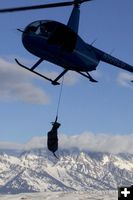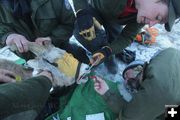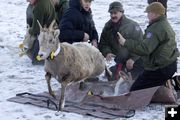

Flying her in
A helicopter capture crew brings a hobbled female bighorn sheep to wildlife managers with the Wyoming Game and Fish Dept. near Jackson. Photo by Mark Gocke, Wyoming Game & Fish.
|


Tonsil swab
Wildlife managers with the Game and Fish Department collect a tonsil swab for disease monitoring from a female bighorn sheep. Photo by Mark Gocke, Wyoming Game & Fish.
|


GPS collar
Wildlife managers fit a bighorn ewe with a GPS collar to track her travels. Photo by Mark Gocke, Wyoming Game & Fish.
|


Released
Wildlife managers release a bighorn ewe after collecting tissue samples and fitting it with a GPS collar to monitor her survival and movements. Photo by Mark Gocke, Wyoming Game & Fish.
|
|
WYG&F continues bighorn sheep research
Learning more about migration patterns and testing for disease sampling
by Wyoming Game & Fish
February 11, 2014
The Wyoming Game and Fish Department is continuing its multi-year research project on bighorn sheep in the Jackson Region. Recently, ten female bighorn sheep were captured for disease sampling with eight of those being fitted with radio collars in an effort to learn more about their survival and migration patterns and the presence of disease. Since 2011, a total of 29 bighorn ewes have been collared with 19 of those currently still alive.
The Jackson herd, which typically numbers approximately 500 animals, has experienced two known significant die-offs over the years. In 2002, it was estimated that as many as 50 percent were lost due to a pneumonia outbreak and another estimated 30 percent lost again in 2011. Near Dubois, the Whiskey Basin herd in the Wind River Range has struggled through several pneumonia outbreaks as well. Other bighorn sheep herds across the Rocky Mountain region have also experienced significant declines in population due to pneumonia in recent years.
While there are several pathogens that may cause pneumonia in bighorn sheep, many of these are suppressed unless the animal becomes weakened by other pathogens or environmental stresses. Once the animalís immune system is undermined, these pathogens are able to establish themselves and cause disease. Many questions remain regarding how different combinations of pathogens, environmental stressors, population density, or nutritional condition may contribute to triggering a pneumonia outbreak.
Laboratory results from sheep that have died in the past indicate the sheep have had Mycoplasma ovipneumoniae, a pathogen that has been implicated as contributing to other bighorn sheep die-offs across the West.
"While there is some debate as to the virulence of this agent in bighorn sheep, its presence serves as a red flag to wildlife managers and calls for closer monitoring of the stateís bighorn sheep herds," according to Hank Edwards, a Wildlife Disease Specialist with the Wyoming Game and Fish Department.
Over the past three years, GPS collars were fitted on animals wintering in five distinct areas near Jackson: the Gray Hills, Red Hills and Slide Lake areas in the Gros Ventre drainage, as well as Miller Butte on the National Elk Refuge and Hoback Canyon south of Jackson. This year, six bighorn ewes were captured east of the National Elk Refuge with an additional two animals collared in the Hoback area near Camp Creek. The marked animals help identify migration corridors between winter and summer ranges, and provide information as to whether the different segments of the herd intermingle on lambing and summer ranges. This distribution information also will help wildlife managers determine the potential scope of future pneumonia outbreaks, should they occur.
Wildlife managers have learned that sheep collared on the National Elk Refuge migrate to a high elevation plateau east of the "Sleeping Indian", or Sheep Mountain. Also, several ewes migrated into Granite Creek, to an area southwest of Granite Hot Springs. Sheep that were collared in the Gros Ventre also migrated to the plateau east of the Sleeping Indian, and to high elevation areas in Crystal Creek.
"The results of our disease sampling will become part of a larger database being shared with wildlife managers from surrounding states, giving everyone a better understanding of the potential diseases bighorn sheep are experiencing across their range," said Wyoming Game and Fish Department Jackson Wildlife Coordinator, Doug Brimeyer.
Funding for the disease monitoring effort this winter came from the Wyoming Wild Sheep Foundation while funding for the radio collar study came from a variety of sources including the Wyoming Governorís Big Game License Coalition, University of Wyoming, Montana State University, and the Jackson Chapters of Sportsmen for Fish & Wildlife and Safari Club International.
Photos by Mark Gocke, Wyoming Game & Fish
|



